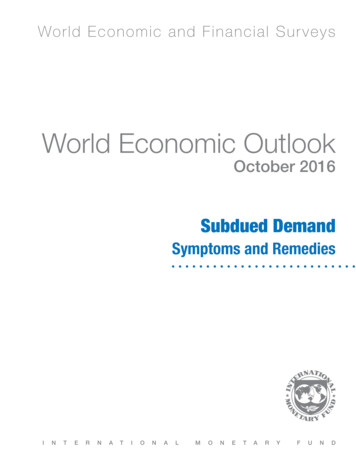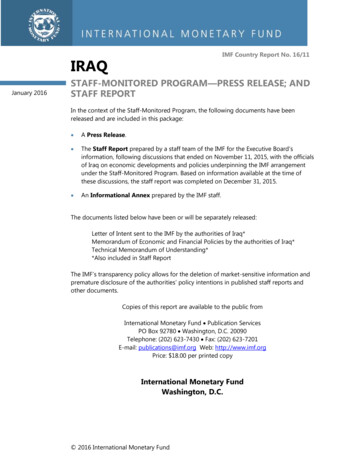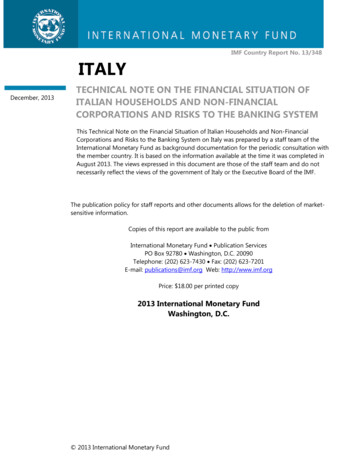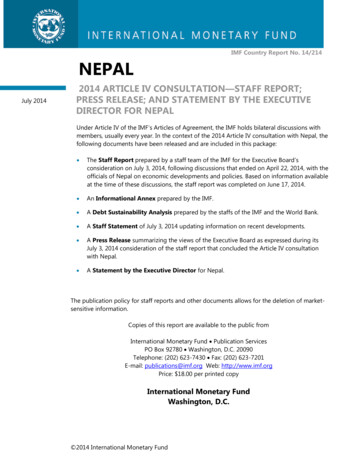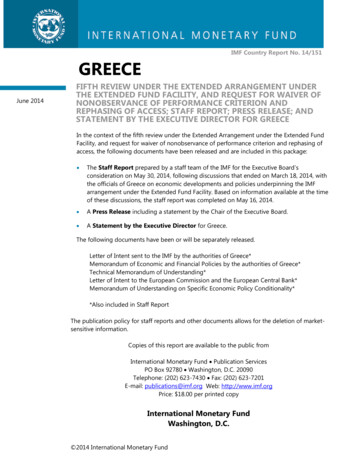
Transcription
IMF Country Report No. 14/151GREECEJune 2014FIFTH REVIEW UNDER THE EXTENDED ARRANGEMENT UNDERTHE EXTENDED FUND FACILITY, AND REQUEST FOR WAIVER OFNONOBSERVANCE OF PERFORMANCE CRITERION ANDREPHASING OF ACCESS; STAFF REPORT; PRESS RELEASE; ANDSTATEMENT BY THE EXECUTIVE DIRECTOR FOR GREECEIn the context of the fifth review under the Extended Arrangement under the Extended FundFacility, and request for waiver of nonobservance of performance criterion and rephasing ofaccess, the following documents have been released and are included in this package: The Staff Report prepared by a staff team of the IMF for the Executive Board’sconsideration on May 30, 2014, following discussions that ended on March 18, 2014, withthe officials of Greece on economic developments and policies underpinning the IMFarrangement under the Extended Fund Facility. Based on information available at the timeof these discussions, the staff report was completed on May 16, 2014. A Press Release including a statement by the Chair of the Executive Board. A Statement by the Executive Director for Greece.The following documents have been or will be separately released.Letter of Intent sent to the IMF by the authorities of Greece*Memorandum of Economic and Financial Policies by the authorities of Greece*Technical Memorandum of Understanding*Letter of Intent to the European Commission and the European Central Bank*Memorandum of Understanding on Specific Economic Policy Conditionality**Also included in Staff ReportThe publication policy for staff reports and other documents allows for the deletion of marketsensitive information.Copies of this report are available to the public fromInternational Monetary Fund Publication ServicesPO Box 92780 Washington, D.C. 20090Telephone: (202) 623-7430 Fax: (202) 623-7201E-mail: publications@imf.org Web: http://www.imf.orgPrice: 18.00 per printed copyInternational Monetary FundWashington, D.C. 2014 International Monetary Fund
GREECEGREECEMay 16, 2014FIFTH REVIEW UNDER THE EXTENDED ARRANGEMENT UNDERTHE EXTENDED FUND FACILITY, AND REQUEST FOR WAIVEROF NONOBSERVANCE OF PERFORMANCE CRITERION ANDREPHASING OF ACCESSEXECUTIVE SUMMARYExtended Arrangement. On March 15, 2012, the Executive Board approved a four-yeararrangement in the amount of SDR 23.79 billion (2,159 percent of quota; 28 billion).Purchases totaling SDR 7.2 billion ( 8.1 billion) have been made so far, and a purchase in theequivalent of SDR 3 billion ( 3.5 billion) is proposed to be released on the completion of thereview. Euro area countries have so far disbursed 139.9 billion since this program’s approval(of 144.6 billion committed), of which 48.2 billion was for bank recapitalization.Developments. Significant progress has been made toward rebalancing the economy. Thefiscal primary and external current account balances are in surplus. Investor sentiment hasimproved, and the government successfully placed a medium-term bond. The economy ispoised to grow in 2014, after six years of deep recession. All this bodes well for a potentiallyvirtuous cycle of recovery to take hold. But a number of challenges remain to be overcomebefore stabilization is deemed complete and Greece is on a sustained and balanced growthpath. The real exchange rate remains overvalued, and non-tourism exports are relativelyweak. Banks face a mountain of bad loans that will require adequate capital and oversight toclean up, absent which the prospects are of a prolonged deleveraging antithetical to theassumed recovery. Fiscal gaps are projected for 2015–16, and public debt remains very high.Policies. The authorities over-performed significantly on their 2013 fiscal primary balancetarget, achieving a surplus of 0.8 percent of GDP. Although the carryover of the overperformance to 2014 is small, the authorities are on track to achieve this year’s target. Theyare implementing a number of structural reform commitments, with a notable accelerationof product and service market liberalization, where progress has lagged. However, in thearea of labor market reforms, where Greece has made important progress in the past, theprogram is now falling short of targets. Following the Bank of Greece’s stress tests, the HFSFbuffer has been set aside to safeguard financial stability, and ambitious steps are planned tostrengthen the private debt resolution framework. Reforms to tax codes have beenlegislated, aimed at simplifying the system and making tax administration easier and, thus,addressing longstanding weaknesses. But at the same time, the authorities need to guardagainst pressure to rollback progress. On public administration reform, progress is mixed asGreece is struggling to introduce performance-based management and address the tabooagainst mandatory dismissals.
GREECEApproved ByReza Moghadam andHugh BredenkampDiscussions for the review were held during September 17–29,November 5–20, December 4–5 and 11–16, 2013, and February 24–March 18, 2014. The mission met with the Minister of Finance,Governor of the Bank of Greece, other cabinet ministers, and staff inthese and other ministries. The mission also met with private banks,think tanks, and employer associations. The staff team comprised, atvarious times, P. Thomsen (head), R. Goyal, J. Bersch, G. Gottlieb,N. Hobdari, A. Kangur, W. Maliszewski and M. Shamloo (EUR); I.Petrova and H. Jin (FAD); B. Rayner (SPR); O. Frecaut and D. Monaghan(MCM); W. Bergthaler, G. Esposito, A. Gullo, N. Rendak and A. Rosha(LEG), and M. Alves (STA). W. McGrew, S. Eble, M. Athanasopoulou,G. Gatopoulos, and M. Kalimeri (IMF resident representative office)assisted the mission. J. Manning and C. Piatakovas (EUR) assisted fromheadquarters. T. Catsambas (OED) participated in some meetings.CONTENTSCONTEXT 4RECENT DEVELOPMENTS 4DISCUSSIONS 9A. Outlook 9B. Economic Policies 9PROGRAM MODALITIES 20STAFF APPRAISAL 22BOXES1. Magnitude and Quality of Greece’s Fiscal Adjustment 252. Stress Test 273. Findings of Privatization Review 294. Exceptional Access Criteria 30FIGURES1. Demand Indicators, 2007–14 312. Supply Indicators, 2007–14 323. Labor Market Developments, 2007–13 334. Inflation Developments, 2005–14 345. Major Components of Tradeables and Nontradeables in HICP Inflation, 2007–14 356. Competitiveness Indicators, 2005–14 367. Balance of Payments, 2005–14 378. Revenue and Expenditure Trends, 2000–13 382INTERNATIONAL MONETARY FUND
GREECE9. Financial Indicators, 2007–14 3910. Money and Banking Developments, 2007–14 4011. Household Balance Sheet, 2007–14 4112. Corporations’ Balance Sheet, 2005–14 42TABLES1. Selected Economic Indicators, 2010–15 432. Summary of Balance of Payments, 2011–19 443. General Government Operations, 2011–17 454. Modified General Government Cash Balance, 2012–17 465. General Government: Statement of Operations (GFSM 2001, flows), 2011–16 476. Monetary Survey, 2011–15 487. Monetary Financial Institutions (excl. BoG)—Uses and Sources of Funds, 2011–16 498. Core Set of Financial Soundness Indicators for Deposit-Taking Institutions, 2009–13 509. Financial Balance Sheet (GFSM 2001, stocks), 2010–13 5110. Implementation of Structural Reforms 5211. Medium-Term Macro Framework, 2012–19 5312. Selected Structural Reforms Ahead, 2014 5413. Schedule of Proposed Purchases under the Extended Arrangement, 2012–16 5514. State Government Financing Requirements and Sources, 2013–16 5615. External Financing Requirements and Sources, 2011–19 5716. Indicators of Fund Credit, 2012–26 58ANNEXI. Debt Sustainability Analysis 59APPENDIXESI. Letter of Intent 70Attachment I. Memorandum of Economic and Financial Policies 72Attachment II. Technical Memorandum of Understanding 107II. Letter of Intent to the European Commission and the European Central Bank 132Attachment I. Memorandum of Understanding on Specific Economic PolicyConditionality 134INTERNATIONAL MONETARY FUND3
GREECECONTEXT1.Greece has continued to make significant progress in rebalancing the economy. Thescale of pre-crisis imbalances and indebtedness—an overall fiscal deficit of 15½ percent of GDPat end-2009, an external current account deficit of 11 percent of GDP, and public debt of nearly130 percent of GDP—meant that Greece had no option but to undertake a sizeable adjustment,when the capital inflows that financed them came to a sudden stop in early 2010. By end-2013,the primary fiscal and external current account balances were in surplus. To have reached asurplus so swiftly is an extraordinary adjustment by any international comparison.2.But Greece has lagged on productivity-enhancing reforms. Political turmoil in 2011–12 and questions in Europe about Greece’s place in the euro area exacerbated uncertainty andemboldened vested interests opposed to reforms. As a result, adjustment has been throughrecessionary channels (compression of real spending and income) rather than productivity gains.Real output has declined by close to 25 percent since 2007. Unemployment has risen to around26½ percent, of which over two-thirds are long-term unemployed. The share of the populationat risk of poverty increased from 20 to 23 percent over 2009–12, and the income distributiondeteriorated slightly (the Gini coefficient rose from 33 to 34 percent over 2009–12).3.Political support for the EFF-supported program is fragile. Adjustment fatigue has setin, and the coalition government has a reduced majority of just two seats in the 300-memberparliament. This is making it difficult to move forward boldly and swiftly with needed reforms,and contributed to significant delays in reaching understandings on a policy package sufficientto warrant completion of this review.RECENT DEVELOPMENTS4.There are initial signs of economic stabilization (Table 1 and Figures 1–3). Real GDPfell by 3.9 percent in 2013, better than the1515Contributions to GDP (Percent)4.2 percent contraction projected at the last1010review, as stronger-than-expected tourism receipts55mitigated the impact of ongoing fiscal adjustment00and private wage correction. The latest activity and-5-5confidence indicators suggest some furtherimprovement in economic conditions in early 2014; -10-10ImportsExportse.g., the PMI in manufacturing has exceeded 50,-15-15Fixed investmentfor the first time since mid-2009, andPublic consumption-20-20Private consumptionunemployment, which is the highest in the EU, hasReal GDP growth (y-o-y percent change)-25-25declined slightly in recent months. The Q1 GDP2007 2008 2009 2010 2011 2012 2013 2014flash estimate was -1.1 percent year-on-year.5.Internal devaluation is underway, but the REER remains over-valued (Figures 4–6).Private sector nominal wages have fallen by about 16 percent since 2009. As a result,4INTERNATIONAL MONETARY FUND
GREECEcompetitiveness measured by the ULC-based real effective exchange rate (REER) has improvedconsiderably. The wage decline has put downward pressure on consumer prices, especiallynontradables, and the GDP deflator, which are clearly falling. But price declines have not beencommensurate with wage declines, reflecting rigidities in product and service markets, andimprovements in the CPI-based REER have been much more limited. The CPI-based REERremains over-valued by about 10 percent, which in the context of the currency union implies theneed for continued lower inflation relative to trading partners.115Wages and Prices, SA (2007 100)1151101051059590HICP at constant taxesGDP deflatorAverage compensationof employees2007 2008 2009 2010 2011 2012 2013 2014130REER (2000 100)11010013012012011011010095CPI-based100GDP 0820102012Sources: European Central Bank; Eurostat; Elstat; Haver Analytics; and IMF staff calculations.6.The external current account registered a surplus in 2013, for the first time indecades, but non-tourism exports continue to perform poorly (Table 2, Figure 7). Last year,strong tourism receipts and oil exports, as well as large EU transfers, contributed to the improvedbalance. However, Greece’s export performance remains generally weak, and most of the140140adjustment since 2009 is due to a contractionExports Excluding Oil and Tourism (2007 100,of imports. For example, exports excluding12-month rolling average)130130rdsGreecetourism and oil (which comprise about 2/3Irelandof total exports) have lagged significantly120120PortugalSpainother euro area “periphery” countries. This110110reflects inter alia sluggish improvements inprice competitiveness and limited financing.100100Commensurate with the over-valued REER, the9090underlying structural external current accountposition remains relatively unfavorable, at an8080estimated deficit of 4 percent of GDP in 2013.2008200920102011201220132014Sources: Bank of Greece; and IMF staff calculations.7.The government achieved asignificant primary fiscal surplus in 2013, well above target and ahead of schedule (Tables3–5, Figure 8). The surplus reached 0.8 percent of GDP compared to a zero target, reflectingunderspending of the budget, one-off adjustments, and higher revenue outturns toward end-INTERNATIONAL MONETARY FUND5
GREECE2013.1 State spending was lower than budgeted by 0.8 billion, and state revenues were higherthan expected, including from frontloading EU funds of 0.7 billion. As such, the carryover of theover-performance to 2014 is small. Greece now has the highest cyclically-adjusted primarybalance in the euro area. The adjustment has generally shielded the vulnerable, althoughimproved tax administration would have resulted in a fairer distribution of the burden (Box 1).8.Financial conditions have improved significantly since mid-2012 (Tables 6–7,Figures 9–10). Overall, staff calculations of a financial conditions index2 point to easier financialconditions, but still tighter than neutral. Reliance on central bank funding declined by over 95 billion from its peak in 2012 to 62 billion at end-April 2014. In particular, emergencyliquidity assistance declined to just 3 billion, reflecting an increase in banks’ eligible collateral,interbank repo transactions, and recent share capital increases. Beyond an initial recovery,deposits have not been returning. But deposit rates have declined from their peak of 3 percent in2012 by 120 bps. Average lending rates have declined by 80 bps over the same period, and nowstand at 5.5 percent. While the resulting rise in the spread has increased banks’ core profitability,bank deleveraging has continued and credit is contracting at an annual rate of 4 percent.1.5Financial Conditions Index(6-month moving 1.5-2.02003200520072009201120132015Credit (Year-on-year percent 5-5-5-2.0-10-102007 2008 2009 2010 2011 2012 2013 2014Sources: Bank of Greece; and IMF staff calculations.9.Investor interest has increased, and the government re-accessed markets for thefirst time in four years. Yields on long-term Greek government bonds have fallen to below preprogram levels. The government raised 3 billion in 5-year bonds at a yield of 4.95 percent inmid-April, providing a benchmark yield for banks and corporate seeking to re-access markets.Two pillar banks, Alpha and Piraeus, raised capital from the private sector, to cover not onlyrelatively small baseline capital needs identified by the stress test (see below) but also thepreference shares held by the government since 2009. The two other pillar banks, NBG and1The surplus is smaller than the estimate reported in the April 2014 WEO and Fiscal Monitor owing tostatistical adjustments made by Elstat and Eurostat on the timing of recording certain items.2The index is computed using a principal component analysis to capture in a single variable theinformation content of several financial indicators, such as interest rates, asset prices, and credit (seeManning, Jonathan, and Maral Shamloo, 2014, “A Financial Conditions Index for Greece,” IMF mimeo).6INTERNATIONAL MONETARY FUND
GREECEEurobank, also raised their substantial baselinecapital needs from the private sector. Moreover,Piraeus borrowed from the markets in March 2014,the first issuance by a Greek bank in four years,followed by NBG in April.10.Bank balance sheets remain fragile withvery high nonperforming loans (NPLs) and lowquality capital (Table 8, Figures 11–12). Althoughfinancial stability has been maintained through thisfiscal crisis by substantial injections of public capitaland massive central bank liquidity support, theprecipitous decline in output has inflicted a severetoll on private sector balance sheets. NPLs andrestructured loans (which according to Blackrock’sasset quality review have a high risk of reneweddefault) reached 40 percent of total loans by end2013, the coverage ratio (provisions over NPLs) was49 percent, and NPLs net of provisions exceededbanks’ capital (138 percent). Collateral valuescontinue to fall apace, adding to the debt burdenof the private sector. Further, part of banks’ capitalis of low quality, consisting of negative goodwilland deferred tax assets that cannot absorb losses iftheir financial conditions were to deteriorate.11.404010-Year Government Bond Yield (Percent)3535GreeceIreland 08200920102011201220132014Sources: Bloomberg; and IMF staff calculations.1/ Shorter maturities from Oct., 2011 to Mar., 2013.50HouseholdsNPLs (Percent of total loans)CorporationsTotal (including restructured loans)405040Total30302020101000201020112012 '13Q1 '13Q2 '13Q3 '13Q4Sources: Bank of Greece; and IMF staff calculations.There has been progress, albeit uneven, on fiscal institutional reforms. Tax administration. Key performance indicators (KPIs) improved in 2013 relative to 2012(TMU Annex Table I.1), but fell short of the targets owing to delays in transferringexperienced staff from other public bodies and completing new recruitments, continuedpolitical interference in operations, and slow roll-out of reforms to local tax offices. Public financial management. Legislative and IT improvements have reduced delays inpayment processes and reduced discrepancies in reporting (TMU Annex Table I.2). But arrearsclearance has been delayed. According to the program definition, the stock of generalgovernment arrears fell from 8.2 billion at end-2012 to 3.9 billion at end-2013, comparedwith targeted elimination, due in part to a lack of funds from delayed program reviews andreflecting 3.4 billion in new arrears accumulation (importantly from the social budget,including hospitals). As a consequence, the end-2013 performance criterion on the narrowlydefined domestic arrears and the indicative target on the broadly-defined stock were missed.INTERNATIONAL MONETARY FUND7
GREECE Public administration. The overall headcount has been reduced by 161,000 since 2010(19 percent reduction).3 On the mobility and exit scheme, which is aimed at helpingrejuvenate the administration by bringing in motivated workers with needed skills andtackling the legacy of patronage hiring, the end-March 2014 exit and end-2013 mobilitytargets were reportedly met as prior actions. Exits were mostly from narrow groups, includingthe closure of the public broadcasting company, doctors in the public healthcare system whochose to exit rather than accept full-time public sector jobs, school guards, and disciplinarycases. But beyond these focused one-offs, exits have not been based on performance andconstitutional restrictions against mandatory, performance-based dismissals remain animpediment. The authorities have undertaken other initiatives, such as passage of a newannual performance system to limit the share of employees receiving a top grade.12.Key structural reform commitments are being implemented, but with delays, whilesome others are being re-phased (Table 10). Greece has had one of the largest improvementssince the crisis on the World Bank’s Doing Business indicator and the OECD’s overall ProductMarket Regulations index. However, the improvements are from a low base, and under bothindicators, Greece remains far from the euro area average. Key program commitments targetedfor the second half of 2013 were implemented as prior actions, such as the OECD competitionassessment (“toolkit”) to liberalize four key sectors, the reduction in social security contribution(SSC) rates to lower the high tax wedge, nuisance tax reform, and opening regulated professions.Others related mainly to the labor markets are being re-phased to late DNK703.020132.070Source: World Bank, Doing Business.1/ Shows how far is an economy's average score of doingbusiness indicators from that of the best performer. Rangesfrom 100 (best) to 0 (worst).Product Market Regulation (Lower valuescorrespond to more competition-friendly policies)802009503.0AUT201390DEU80Doing Business Indicators:Distance to Frontier 1/ (Percent)NLD90Source: OECD.13.All but one end-2013 program performance criteria were met, but all indicativetargets and most structural benchmarks were missed (MEFP Tables 1 and 2). The authoritieshave requested a waiver of nonobservance for the missed quantitative performance criterion on3Of this reduction, 87,000 were permanent public sector staff (12 percent reduction) and 75,000 werecontractual (66 percent reduction). The reduction is not comparable to the MEFP target of 150,000 between2010 and 2015 because changes in coverage increased the starting base by 105,000 which now alsoincludes state enterprise workers. There has been a further significant increase in the hiring of EU-financedtemporary workers. Nonetheless, Greece appears on track to meet the 150,000 target.8INTERNATIONAL MONETARY FUND
GREECEdomestic arrears clearance. Several of the missed structural benchmarks are being implementedas prior actions or re-phased, or corrective actions are being taken (MEFP Tables 3 and 6).DISCUSSIONSA. Outlook14.With economic developments broadly in line with the program, the macroeconomicframework is largely unchanged (Table 11). Growth is projected to pick up to about ½ percentin 2014, as the economy benefits from less fiscal adjustment this year, strong tourism bookings,and improving market access for Greek banks and corporates. Over the medium term, reflectinga rebound from very compressed levels, growth is projected above the estimated long-termpotential growth of about 2 percent per year, assuming strong reform implementation. Givenample spare capacity and recent developments, inflation and GDP deflator projections have beenrevised down to -0.8 and -0.7 percent for 2014. With the output gap not projected to closebefore 2019, price dynamics in Greece are expected to trail those of its trading partners. Theexternal current account should remain strong in 2014 on the back of another good tourismseason and a recovery in shipping, but will likely face headwinds in 2015 as imports rebound withdomestic demand, official interest payments increase, and EU funds fall with the new cycle.15.Growth risks could be tilting to the upside for 2014, but are tilted to the downsideover the medium term. An upside risk in the near term is a faster improvement in investorinterest, boosting investment. But several downside risks could derail the expected recovery orweigh on growth, especially over the medium term: domestic political instability, including fromadjustment fatigue; slippages in reform implementation, as vested interests push back; the failureto deal effectively with bank balance sheet vulnerabilities; longer than expected deflation that willbe a further drag on private balance sheets; and external factors such as lower euro area growth,monetary tightening that reduces global risk appetite, and a potential escalation of the crisis inUkraine that could hit Greece through the trade channel.16.Public debt dynamics remain broadly unchanged (Annex I). After peaking at about174 percent of GDP this year, debt is expected to decline to 128 percent in 2020 and 117 percentof GDP in 2022, before additional contingent relief measures from Greece’s European partners.This rapid decline is predicated on primary surpluses of over 4 percent of GDP being achievedand sustained for several years as well as relatively high nominal GDP growth. Sustainabilityremains subject to notable downside risks, in particular, to fiscal slippages, delayed structuralreforms that slow competitiveness gains, and higher than expected deflation.B. Economic Policies17.Discussions focused on policies to bring the program back on track, notablyreforms to underpin economic growth. The priorities are ensuring the financial sector isadequately capitalized to start extending credit and supporting the economy (rather thanINTERNATIONAL MONETARY FUND9
GREECEcontinue deleveraging), and implementing structural reforms to improve the investment climateand boost productivity. Amid limited progress on labor market reform commitments for thisreview, discussions emphasized redoubling efforts on product and service markets, whereprogress has thus far lagged. Absent an acceleration of these reforms, wage adjustment is likelyto overshoot to compensate for the limited price adjustment, and Greece faces a risk ofremaining stuck in a low-growth trap over the medium term. On fiscal policies, discussionscentered on ensuring an adequate basis for meeting fiscal targets in line with the agreed debtsustainability framework, and modernizing the tax system and fiscal institutions.Fiscal policy18.The authorities are on track to achieve the 2014 primary surplus target of1.5 percent of GDP (MEFP ¶4). They are distributing a one-off “social dividend” at a gross cost of 525 million, comprising largely well-targeted cash transfers to low-income households as wellas 38 million for the homeless and uninsured and 37 million for security personnel. They arealso lowering SSC rates and eliminating some nuisance charges (¶22 below) at a net cost ofabout ¼ percent of GDP. The (limited) fiscal space for these actions comes from a number ofmeasures that the authorities are implementing to meet the target, including: (i) locking in partof the under-execution of the 2013 spending by revising spending ceilings in the 2015–18Medium-Term Fiscal Strategy ( 320 million); (ii) taking other structural measures worth aboutFiscal Policies, 2014–15 220 million, such asreducing spending ceilings2014201520142015of extra-budgetary fundsBillions of eurosPercent of GDP( 100 million) and scalingPrimary fiscal balance target2.75.61.53.0back military procurementBaseline (excluding new measures and re-quantification)1.12.10.61.1(about 50 million);Select measures to achieve target(iii) continuingMarginal effect of 2013 measures1.71.31.00.7implementing the newIncome tax reform0.40.40.20.2Withholding tax on pensions0.40.40.20.2Income Tax Code (overExtension of claw-back on health spending0.40.40.20.2 350 million) that, inter alia,Untaxed reserves0.30.00.20.0Revised spending ceilings0.30.20.20.1tightens depreciation rules2014 measures0.10.30.00.1and shifts professionals andReduction in SSC rates-0.4-0.7-0.2-0.4small businesses under aElimination of nuisance taxes0.0-0.10.00.0Social dividend-0.50.0-0.30.0new tax status; andCourt decision on judges-0.2-0.1-0.10.0(iv) applying a withholdingReductions in OAED family and training allowances0.10.20.10.1Savings in Public Investment Budget0.20.00.10.0tax on pensions (overStrengthen SS
FIFTH REVIEW UNDER THE EXTENDED ARRANGEMENT UNDER THE EXTENDED FUND FACILITY, AND REQUEST FOR WAIVER OF NONOBSERVANCE OF PERFORMANCE CRITERION AND REPHASING OF ACCESS; STAFF REPORT; PRESS RELEASE; AND STATEMENT BY THE EXECUTIVE DIRECTOR FOR GREECE In the context of the fifth review under the Extended Arrangement under the Extended Fund

